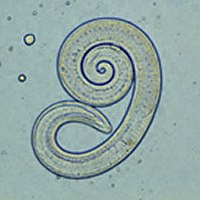
Test sensitivity of a commercial serine protease digestion kit for the detection of Trichinella spiralis and Trichinella pseudospiralis larvae in pig muscle.
Sign Up to like & getrecommendations! Published in 2019 at "Food microbiology"
DOI: 10.1016/j.fm.2018.10.012
Abstract: The reference method for Trichinella detection at meat inspection is the magnetic stirrer method (MSM) utilising HCl-pepsin for pooled sample digestion. Due to availability and quality issues with pepsin, alternative digestion methods are being offered,… read more here.
Keywords: detection; trichinella; spiralis; digestion ... See more keywords

Use of ELISA and Western blot for serological detection of antibodies to E-S antigens of Trichinella spiralis muscle larvae in sera of swine experimentally infected with Trichinella spiralis.
Sign Up to like & getrecommendations! Published in 2018 at "Veterinary immunology and immunopathology"
DOI: 10.1016/j.vetimm.2018.07.010
Abstract: The aim of the present study was to evaluate the detection of trichinellosis using ELISA, and to determine the degree of variation of IgG antibodies against excretory-secretory (E-S) antigens of T. spiralis muscle larvae. Ten… read more here.
Keywords: muscle larvae; trichinella; spiralis; trichinella spiralis ... See more keywords

Purinergic P2X7 Receptor Mediates the Elimination of Trichinella spiralis by Activating NF-κB/NLRP3/IL-1β Pathway in Macrophages
Sign Up to like & getrecommendations! Published in 2021 at "Infection and Immunity"
DOI: 10.1128/iai.00683-20
Abstract: Trichinellosis is one of most neglected foodborne zoonoses worldwide. During Trichinella spiralis infection, the intestinal immune response is the first line of defense and plays a vital role in the host’s resistance. ABSTRACT Trichinellosis is… read more here.
Keywords: infection; intestinal immune; trichinella spiralis; spiralis ... See more keywords

Molecular Docking and In Silico Simulation of Trichinella spiralis Membrane-Associated Progesterone Receptor Component 2 (Ts-MAPRC2) and Its Interaction with Human PGRMC1
Sign Up to like & getrecommendations! Published in 2022 at "BioMed Research International"
DOI: 10.1155/2022/7414198
Abstract: Background. Trichinellosis is a foodborne zoonotic disease caused by Trichinella spp., including Trichinella spiralis. This parasitic disease ranks as seven of the most infectious in the world. In this context, it is important to develop… read more here.
Keywords: receptor component; spiralis; pgrmc1; human pgrmc1 ... See more keywords

A novel cystatin derived from Trichinella spiralis suppresses macrophage-mediated inflammatory responses
Sign Up to like & getrecommendations! Published in 2020 at "PLoS Neglected Tropical Diseases"
DOI: 10.1371/journal.pntd.0008192
Abstract: Trichinella spiralis can modulate host immune responses to retain a suitable environment for its long-term survival. Incidentally, the parasite elicits regulatory effects through immunomodulatory molecule release, which can suppress host inflammation and may be used… read more here.
Keywords: rtscstn; trichinella spiralis; spiralis; cystatin ... See more keywords

Identification and profiling of Trichinella spiralis circulating antigens and proteins in sera of mice with trichinellosis
Sign Up to like & getrecommendations! Published in 2022 at "PLoS ONE"
DOI: 10.1371/journal.pone.0265013
Abstract: Trichinellosis is a zoonotic disease caused by the ingestion of the Trichinella nematode. With a worldwide incidence of approximately 10,000 cases per year, Trichinella spiralis is responsible for most human infections. There are no specific… read more here.
Keywords: trichinellosis; infection; spiralis; spiralis circulating ... See more keywords

TGFβ-activation by dendritic cells drives Th17 induction and intestinal contractility and augments the expulsion of the parasite Trichinella spiralis in mice
Sign Up to like & getrecommendations! Published in 2019 at "PLoS Pathogens"
DOI: 10.1371/journal.ppat.1007657
Abstract: Helminths are highly prevalent metazoan parasites that infect over a billion of the world’s population. Hosts have evolved numerous mechanisms to drive the expulsion of these parasites via Th2-driven immunity, but these responses must be… read more here.
Keywords: expulsion; trichinella spiralis; spiralis; tgf activation ... See more keywords

Extracellular vesicles derived from Trichinella Spiralis larvae promote the polarization of macrophages to M2b type and inhibit the activation of fibroblasts
Sign Up to like & getrecommendations! Published in 2022 at "Frontiers in Immunology"
DOI: 10.3389/fimmu.2022.974332
Abstract: Trichinella spiralis (T. spiralis) is a globally distributed food-borne parasite that can coexist with the host for a long time after infection. Trichinella-derived secretions can regulate the immune response and fibroblasts of the host, but… read more here.
Keywords: extracellular vesicles; spiralis larvae; spiralis; promote polarization ... See more keywords

Immune Cell Responses and Cytokine Profile in Intestines of Mice Infected with Trichinella spiralis
Sign Up to like & getrecommendations! Published in 2017 at "Frontiers in Microbiology"
DOI: 10.3389/fmicb.2017.02069
Abstract: The intestinal phase is critical for trichinellosis caused by Trichinella spiralis (T. spiralis), as it determines both process and consequences of the disease. Several previous studies have reported that T. spiralis induces the initial predominance… read more here.
Keywords: mice infected; trichinella spiralis; spiralis; infection ... See more keywords

Isolation of polymorphic microsatellite loci in the New Zealand endemic sand-binder, Ficinia spiralis (Cyperaceae)1
Sign Up to like & getrecommendations! Published in 2017 at "Applications in Plant Sciences"
DOI: 10.3732/apps.1700039
Abstract: Premise of the study: Ficinia spiralis (Cyperaceae) is a declining sand-binding sedge of ecological and cultural importance. Microsatellite primers were developed in F. spiralis to investigate how population genetic structure is related to the pronounced… read more here.
Keywords: sand; spiralis; spiralis cyperaceae; ficinia spiralis ... See more keywords